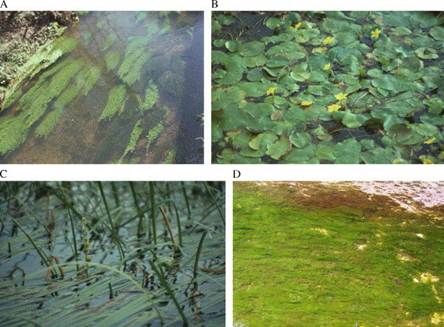Post a comment on the text below
Box 3.1: Change in ecological state - eutrophication of rivers
The increases in the primary production (eutrophication) of water bodies, such as algae and rooted plants, due to significant nutrient inputs is a serious consequence of increased pollution loads in many water bodies. Eutrophication can have significant economic impacts on society and communities that depends on freshwater from affected sources. From the current understanding of lake systems the pre-dominant cause of shift from a macrophyte to phytoplankton dominated system has been identified as the development of algal growths on macrophytes which effectively reduce the available light. There are, however, multiple stable states that can exist between these two extremes, representing interaction between phytoplankton biomass, turbidity, light availability, grazing macroinvertebtates and the feedback effects that exist.
A conceptual model of how eutrophic conditions develop in short-retention-time river systems has been developed by Hilton et al. (2006), based upon the literature available. While there is agreement that nutrient increases are required to develop eutrophic conditions to develop, there is in fact a lack of evidence in short-retention-time rivers and that in fact the interaction of hydraulic drag with light limitation is the most significant factor. The impacts of this interaction and the types of macrophytes that exist through these changing states are shown below in figure 3.6, from a clear flowing river containing tall submerged plants (A) towards dominance of floating leaved plants (B) and emergent plants (C) and finally a river with high nutrient loading dominated by filamentous algae (D). Thus while the lower reaches of long slow flowing or impounded rivers tend towards phytoplankton domination under nutrient-enriched conditions, these short-retention-time rivers should tend towards a dominance of benthic algae driven primarily by the development of epiphytic algal communities reducing light availability. What is also clear from this research is that there are multiple interacting processes involved in the gradual eutrophication of short-retention-time rivers, highlighting the complexity of the system and the difficulty in pinpointing how exactly such a system will respond to anthropogenic disturbance and what essentially constitutes a loss of resilience.
Figure 3.6 Changing states in a river system
Source: Hilton et al. 2006 (text and photos)
You cannot post comments to this consultation because you are not authenticated. Please log in.


